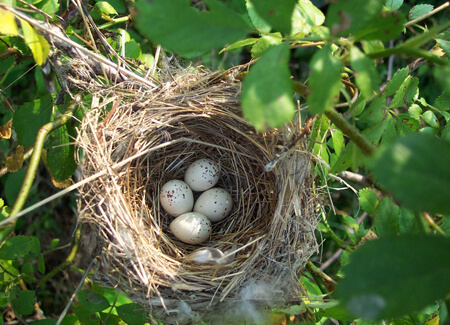 This little flycatcher has a big impact, controlling insect populations around wetlands and waterways. It nests in these important riparian habitats alongside other threatened species, such as the western population of Yellow-billed Cuckoo.
This little flycatcher has a big impact, controlling insect populations around wetlands and waterways. It nests in these important riparian habitats alongside other threatened species, such as the western population of Yellow-billed Cuckoo.
The Southwestern Willow Flycatcher—a subspecies of the wide-ranging Willow Flycatcher—was listed as endangered under the Endangered Species Act in 1995. Rampant development has degraded large portions of this flycatcher's habitat and led to its disappearance throughout much of its historic range.
Livestock grazing, invasive species, and cowbird parasitism pose additional threats.
A Family Affair
The Southwestern Willow Flycatcher closely resembles other races of Willow Flycatcher and several other species of the Empidonax genus, particularly the closely related Alder Flycatcher. The genus name derives from the Ancient Greek words empis, "gnat," and anax, "master," reflecting these birds' insect-eating habits.
The Empidonax flycatchers are renowned by birders as one of the most difficult groups of birds to distinguish by sight alone; expert birders distinguish the Willow Flycatchers from other look-alike species by their loud, raspy "fitz-bew" song.
Sign up for ABC's eNews to learn how you can help protect birds
Aerial Forager
This bird truly is a “master of gnats.” Like other flycatchers, including the Olive-sided Flycatcher, the Southwestern Willow Flycatcher is an insectivore, taking a wide variety of small- to medium-sized insects, including from wasps and bees to flies, beetles, butterflies, caterpillars, and spiders. The birds use a variety of hunting techniques: They hawk insects while in flight, glean them from foliage while hovering, and occasionally pounce onto them on the ground.
Employing a “sit and wait” strategy, these flycatchers are often seen perching upright on exposed snags. They located their prey by sight before dashing out to capture it.
Tiny but Territorial
The Southwestern Willow Flycatcher prefers dense tree and shrub habitat for nesting. Native vegetation—including willows, box elder, buttonbush, and cottonwood—are used, but they also nest in thickets dominated by non-native, introduced species such as tamarisk and Russian olive.
This flycatcher is a late spring breeder, arriving by mid-May from its wintering grounds in Latin America. Males generally arrive first to set up territories, with females arriving a week or two later.
The males establish and maintain territories through a variety of behaviors. Chasing intruders, as well as tail-pumping and bill-snapping to try to intimidate interlopers, are entertaining to see but serious business for the birds, which are highly territorial on both the breeding and wintering grounds.
After pairing up, the female builds the nest, a tiny cup made of fiber, bark, and grass about 3 to 15 feet above the ground. Both parents feed the young, and the pair may raise a second brood later in the season, particularly if their first nesting attempt fails.

Willow Flycatcher Nest, USGS
Ongoing Challenges
Although the U.S. Fish and Wildlife Service (FWS) has listed the Southwestern Willow Flycatcher as endangered and designated Critical Habitat, there are ongoing challenges. For example, a finding published by FWS in 2016 claimed that the bird does not sufficiently differ from the Willow Flycatcher to retain its subspecies status. The de-listing is supported by a number of groups representing industry and development.
However, work on behalf of the Southwestern Willow Flycatcher continues, including a 2016 report by the U.S. Geological Survey that provides new information about the species' habitat and threats.
ABC continues work to preserve riparian habitat throughout the southwest to benefit birds including the Southwestern Willow Flycatcher. Among our efforts is advocating for the San Pedro River, one of the last major undammed rivers in the American Southwest. It runs through the Chihuahuan Desert and the Sonoran Desert in southeastern Arizona.
The San Pedro Riparian National Conservation Area, which protects critical habitat for the flycatcher as well as species such as Elf Owl and Costa's Hummingbird, was the first site designated by ABC as a Globally Important Bird Area. It represents a rare remnant of what was once an extensive network of riparian systems throughout the southwest.
Donate to support ABC's conservation mission!



















































